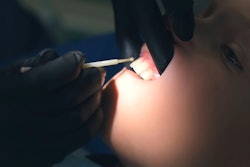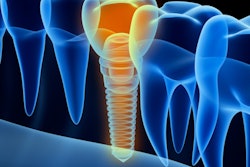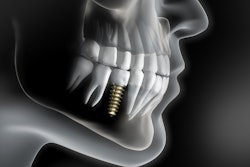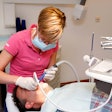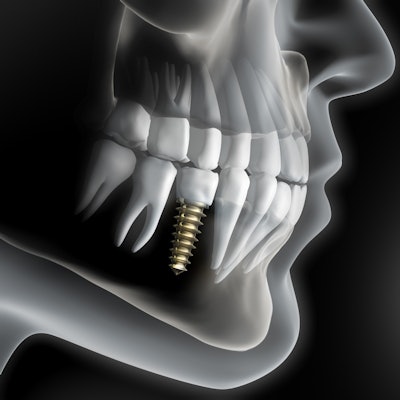
Researchers analyzed the current literature concerning antimicrobial surfaces used on dental implant materials, focusing on microbial population and functional responses, and found five factors that affect peri-implantitis risk. They published their results earlier this month in Dentistry Review.
"The search for optimal implant surfaces is necessary for the reduction of the peri-implantitis burden and the longevity of dental implants," wrote Jon Vernon of the University of Leeds and colleagues (Dent Rev, November 1, 2022). "To date, next generation sequencing methodologies, enabling a greater depth of understanding of the complex interactions between oral microorganisms, host response, and implant surface coatings are under used in this area of research."
Implants are becoming increasingly common in today's practices, especially in the U.S. Projections indicate the potential for up to 23% of the partially edentulous population to opt for dental implants to improve oral aesthetics, mastication, and quality of life. Therefore, ensuring the longevity of implants is critical for positive outcomes.
Vernon and colleagues conducted an extensive search of online databases to investigate the antimicrobial impact of implant surfaces on the oral microbiome, with a particular focus on oral biofilms and the network or interactions within the oral microbiome.
The authors noted that considerable research resources were directed toward the augmentation of implant surfaces to counteract microbial colonization. Based on the review, five factors may impact peri-implantitis risk, the authors stated.
1. Implant materials
When it comes to selecting titanium alloy implants or zirconia ones, according to the review's authors, "the selection of primary implant material may be crucial to the prevention of biofilm accumulation and subsequent peri-implant disease, promoting longevity."
When titanium alloy implants are supplemented with additional metals, such as silver, copper, manganese, and zinc, the metals add persistent antimicrobial potential to the implant material. However, a recent 10-year follow-up study of titanium implants reported a significant association between peri-implantitis and dissolved titanium in the oral milieu. This discovery raises concerns about the undesirable release of particles during titanium corrosion, the authors reported.
Zirconia is used widely in dental implants due to its non-cytotoxicity, strong biocompatibility, and aesthetics.
"Modern implants are often composed of aluminum oxide toughened or yttria-stabilized zirconia, combining the temperature resistant properties of ceramic and fracture-proofing of metal," wrote the authors.
2. Antimicrobial agent release
A surface with degradable, rapid-release antimicrobials protects against infection and aids in long-term implant success. The review authors noted that how this antimicrobial compound is delivered is critical to the longevity of its effect.
While there are multiple types of antimicrobial systems for implants, the authors said it is best to combine a burst-release system with other antimicrobial coating methods. And while there is promising emerging research in other fields in which specific events trigger antimicrobials, the authors suggested that this area still needs further research, specifically concerning the efficacy of these coatings against complex biofilms.
3. Accumulation of plaque
While plaque buildup is thought to cause implant failure, the review confirms that there is "no clear consensus as the influence of the biomass on bone resorption and implant failure."
It's also thought that a rough implant surface may lead to more accumulated plaque, while smooth surfaces are theorized to help prevent plaque buildup. But the review's authors reported that the "ultrasmoothness of surfaces may not be a necessary characteristic for anti-biofilm properties."
4. Epigenetic factors
Molecules in cells that may have a genetic component, microRNA, may affect how well an implant integrates into the surrounding bone. Successful osseointegration influences implant survival, the review authors pointed out.
5. Inflammatory response
Lastly, inflammation is known to negatively impact implant longevity. Therefore, controlling inflammation is key to preventing peri-implantitis.
"The potential pro-inflammatory responses associated with the actual implant surface may be vital to implant survival," the authors stated.




